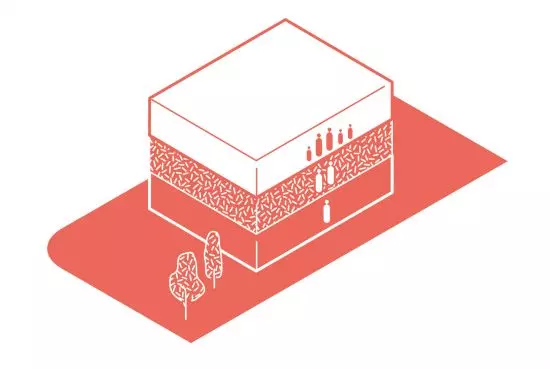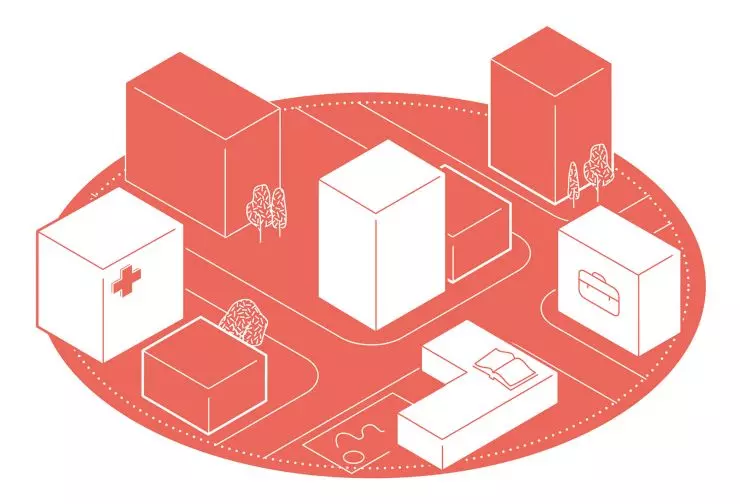We talk about diversity with Mattijs van 't Hoff, a partner at Stipo, a Dutch organization dedicated to supporting the transformation of space, leading and managing urban projects. Stipo brings together specialists from different fields who work together on strategies for creating good space, such as The City at Eye Level, De Stoep (the Dutch name for the space in front of a building), and processes for revitalizing places (place-making).
Zofia Piotrowska, BBGK:At Stipo Rotterdam, you describe yourself as a multidisciplinary team dealing with urban development. This type of activity is not very popular in Poland. What exactly do you do?
Mattijs van 't Hoff: We perform different functions depending on the project we are working on. Sometimes we work as consultants with architects and urban planners. However, we prefer to be involved in projects where we can be more active. We are often approached by property owners who do not know how to deal with them. Sometimes developers have unused areas or buildings, spaces they want to revitalize before starting redevelopment. We then try not to deal with designing the "hardware" (equipment) part, but focus on the parts we call "software" and "orgware." What kind of software should be in a particular place? How can we manage it? But also, what funding and organizational models will be needed to make the place work?



FIRST NEEDSERVICES
Locatingservice establishments in the first floors of residential buildings
© BBGK Architects
Sophie: Orgware, that sounds unusual....
Mattijs: Often the main focus of projects is on urban hardware, i.e. bricks, and sometimes on software, i.e. functions, but still not enough on orgware, i.e. how the space is managed, the use, the ownership structure, or the parties involved in the development process. We need to move away from focusing on the form of cities and turn our attention to how people use them, which is much more a result of what we refer to as software and orgware. This trio is extremely important in design processes. We didn't invent it at Stipo, rather we learned it from people like Jane Jacobs, William H. Whyte and Jan Gehl, who paid attention to which elements of cities are important, make spaces attractive. We observe how public spaces are organized, how pedestrians or cyclists use them, how people move around the city. We pay attention first and foremost to users and functions, secondarily to spaces, only then to buildings.
Sophie: Are you not interested in architecture?
Mattijs: Of course, at the end of the day, it is the architects who have to come up with the spatial structure of the building. But if we don't think of ways to manage the project, it will only be filled with expensive apartments, maybe some cafe on the first floor. It doesn't have much social value. That's why it's so important to design the organizational structure well - how to introduce the functions that are needed to create attractive streets and cities.
Sophie: How do you get developers to think about such a structure?
Mattijs: In the Netherlands, when a developer wants to redevelop an area or a building, he is forced by the city to provide social functions. At Stipo, we advise both local governments and developers on what kind of program fits a given circumstance, a given site - whether it should be a clinic, a nursery, a senior citizen's home or art studios - and what financing models will make the project work.
Zofia: Unfortunately, things are different in our country. Most projects built in Poland are mono-functional housing assumptions. Is it possible to force a program mix in such projects?
Mattijs: The easiest way is when local governments impose requirements on developers. However, we are now seeing that many investors and developers see the long-term benefits of mixed-use development. Tenants of their spaces need cafes, nurseries, doctors. If they have bicycles, they need a bike repair shop. In the Netherlands, having additional services in the neighborhood is financially viable for investments. Their attractiveness increases if there is life on the streets, if the place is liked, by extension it is also safer. In the long run, the mix of functions and diversity has both economic and social value.
Dutch developers and real estate agencies are beginning to recognize that it is not enough to sell apartments alone. If they want to sell an "urban lifestyle," they can't offer units alone, but also the appeal of a city with lively first floors and streets full of people. They have to really believe in such values and such a way of communicating the project; we see them increasingly acting in this way and aiming for a diverse program of neighborhoods.



MIX OF INCOME GROUPS
Designing within a single premise housing intended for different income groups, with a particular focus on developing social housing
© BBGK Architects
Sophie: Do you manage to counteract the gentrification of a given space when you work on processes to create a place, a "destination," especially when the investor ultimately cares about economic value?
Mattijs: Whenever we talk about so-called place-making projects, we come back to the topic of gentrification. Such processes can indeed lead to the gentrification of spaces. Thinking about place-making always starts with recognizing the needs of a neighborhood and its residents. Degraded areas can be revitalized by introducing new functions, and thus make them more attractive to new residents who have money. We usually think of gentrification as a negative phenomenon, while it can also have positive effects. Especially in mono-functional neighborhoods where social housing predominates, the introduction of a different type of housing development can cause a good change. We want neighborhoods to be diverse, because that's good for cities. The first phase of gentrification is not necessarily bad. The problem arises when units become too expensive, social housing is sold off, which again introduces an imbalance. So the question is: what mix is diverse enough in a given neighborhood? In the Netherlands, we have housing corporations that are required to maintain an adequate number of social housing units in cities, in certain neighborhoods. In new developments, there is a set ratio: 30 percent social housing, 30 - at market prices, 40 - for middle-income tenants. This varies from neighborhood to neighborhood, but ideally each area of the city must consist of all three parts.
The question of gentrification recurs, because it is indeed sometimes the case that users of social housing are forced to move from one place to another, they are thrown out, which is never good, because it destroys social relations. Such problems should be solved at the local government level, we should take care of existing communities.



FUNCTIONAL MIX
Mix of functions allows active use of urban space throughout the day, reduces unnecessary communication and promotes social integration
© BBGK Architects
Sophia: How are the apartments that are part of this forced social mix managed? Are private developers transferring designated social housing into public hands?
Mattijs: Social housing in the Netherlands is built and rented exclusively by housing corporations, which are special organizations dedicated to this type of housing. Local governments have agreements with housing corporations to maintain an adequate number of social housing units in given locations, if necessary. Cities also have legal tools, such as local plans, and can designate areas for the development of different types of housing, or set minimum thresholds. Sometimes this works through an agreement with the investor - the plan is amended to allow higher development, and in return 30 percent of the project must consist of social housing. In such cases, the investor chooses a housing corporation to work with and to manage these apartments. Very often investors work in partnership with such corporations to obtain a development permit from the municipality.



SOCIAL INFRASTRUCTURE
Expanding and supplementing social infrastructure - public, such as schools and kindergartens, as well as allowing the emergence of commercial offerings
© BBGK Architects
Sophie: Where did these housing corporations come from?
Mattijs: They have existed in the Netherlands for more than a century, the first ones being established in 1901. In the beginning they were small organizations with fifty-hundred apartments. Now there are at least several large corporations with thousands of apartments in every city. From the rent of current tenants they are able to finance new projects. Sometimes new corporations are set up specifically for a project, but it's much easier to work with existing corporations because they have a lot of knowledge and experience. Dutch housing corporations are among the largest investment entities and property owners in the country.
Sophie: That's a good way to maintain a long-term mix when it comes to the housing program, but what about other functions?
Mattijs: Yes, housing corporations can provide that differentiation when it comes to housing, but it's hard to find a similar system for a small business. There is a well-known story where tenants get a low rent for five years, and then the price triples and they have to move out. That's why we are now trying to develop corporations for social workplaces that could manage the service units. We're trying to create a system, a sustainable system that provides a long-term mix of functions in neighborhoods. This comparison may sound strange, but we want to operate on similar principles to Schiphol, one of the largest international airports. There are a lot of stores there, they are supposed to be profitable, but it is also important that passengers feel comfortable there, so there are less profitable functions as well.



INTEGRATION OF DIFFERENT GENERATIONS
Designing offerings for different social groups allowing intergenerational integration and inclusion of excluded groups (seniors, people with disabilities) in urban life
© BBGK Architects
We are looking for a similar combination. When there are a lot of individual building owners, each of them wants to make money from renting the premises, so they look for a similar type of tenant, similar stores. If one entity appeared, not a landlord, but a rental management organization, we could combine functions that have financial value and those that have social value. In this way, we would create a conglomerate of interesting services, profit-making supermarkets and spaces for culture that would attract people. For the time being, such a system does not yet exist, but we are trying to find projects in which we would be able to bring together various entities to put it into practice. If the housing corporation, the property owners and the local government agreed to work together, we could establish partner corporations, create a sustainable and balanced management system. Such a project would combine the orgware and software parts.
Sophie: Also with the hardware part - at the end of the day, in order to offer a variety of services, you need to have properly designed spaces in the first floors of buildings.
Mattijs: Just now, together with architects from Heren 5 and developer AM we have finished working on a project for the Sloterdijk district, south of Amsterdam. It deals with creating active first floors of buildings and combining residential functions with workplaces and services. We designed a system of rules for the ground floors of buildings - if there are large functions, such as a supermarket, they must be enclosed by small units; building entrances must be no more than 10 meters apart, and so on. This set of rules is meant to ensure lively and interesting streets. We were commissioned by the city to push developers and architects to create better building ground floors and combine different functions. We consulted the document with designers, who think we are proposing the right solutions, but say: we would like to design this way, but developers don't agree, because the building is then more expensive, or becomes more complicated. That's why the local government has prepared regulations that are part of a larger strategy to support livable streets. The rules we are proposing can be guidelines that give extra points in bidding procedures, thus increasing the chances of winning.



15-MINUTE CITY
Location of services, workplaces and recreational areas within a 15-minute walking distance allows residents to forgo daily car use and builds local community cohesion
© BBGK Architects
The solutions we have prepared are obvious, based on common sense, and were established to further support architects in design. To give them an ironclad argument - if the local government orders it, you have to comply. At least in the Netherlands, it often happens that architects propose solutions that are good for the city, but are restricted by investors. Such a booklet - what to do and what not to do - can help them in discussions with their clients and make the case that it is not money that matters most, but good solutions to create friendly streets, neighborhoods and cities.




























